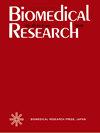水飞蓟宾素通过黑色素瘤细胞中的PKA和p38 MAPK信号通路促进黑色素生成。
IF 1.3
4区 医学
Q4 MEDICINE, RESEARCH & EXPERIMENTAL
引用次数: 6
摘要
水飞蓟宾是一种从水飞蓟中分离得到的黄酮木脂素。据报道,水飞蓟宾具有多种生物活性;然而,它对黑色素形成的影响尚不清楚。本研究探讨水飞蓟宾对黑色素瘤细胞黑色素生成的影响及其分子机制。我们的研究结果表明,水飞蓟宾可显著增加小鼠B16-F1和人HMV-II黑色素瘤细胞中的黑色素含量。水飞蓟宾激活细胞内酪氨酸酶活性和酪氨酸酶、酪氨酸酶相关蛋白(TRP)-1、TRP-2和小眼相关转录因子(MITF)的表达。此外,水飞蓟宾还增强了环amp响应元件结合蛋白(CREB)、蛋白激酶A (PKA)和p38丝裂原活化蛋白激酶(MAPK)的磷酸化,但对Akt和细胞外信号调节激酶(ERK)没有磷酸化作用。特异性PKA (H-89)和p38 (SB203580)抑制剂显著减弱水飞蓟宾素介导的黑色素合成。这些结果表明水飞蓟宾通过上调PKA和p38途径激活的黑色素生成酶的蛋白表达,导致CREB磷酸化和MITF表达,是一种有效的黑色素生成刺激物。因此,水飞蓟宾可能有潜力用于治疗色素减退症。本文章由计算机程序翻译,如有差异,请以英文原文为准。
Silibinin promotes melanogenesis through the PKA and p38 MAPK signaling pathways in melanoma cells.
Silibinin is a flavonolignan isolated from milk thistle (Silybum marianum). Silibinin has been reported to possess multiple biological activities; however, its effect on melanogenesis remains unclear. This study investigated the effect of silibinin on melanogenesis in melanoma cells and the associated molecular mechanism. Our findings demonstrated that silibinin markedly increased melanin content in murine B16-F1 and human HMV-II melanoma cells. Silibinin activated intracellular tyrosinase activity and expression of tyrosinase, tyrosinase-related protein (TRP)-1, TRP-2, and microphthalmia-associated transcription factor (MITF). Furthermore, silibinin enhanced the phosphorylation of cyclic AMP-responsive element-binding protein (CREB), protein kinase A (PKA), and p38 mitogen-activated protein kinase (MAPK) but not of Akt and extracellular signal-regulated kinase (ERK). The specific PKA (H-89) and p38 (SB203580) inhibitors significantly attenuated silibinin-mediated melanin synthesis. These results suggest that silibinin is an effective stimulator of melanogenesis through upregulation of the protein expression of melanogenic enzymes activated by the PKA and p38 pathways, leading to CREB phosphorylation and MITF expression. Therefore, silibinin may have potential for use in the treatment of hypopigmentation disorders.
求助全文
通过发布文献求助,成功后即可免费获取论文全文。
去求助
来源期刊

Biomedical Research-tokyo
医学-医学:研究与实验
CiteScore
2.40
自引率
0.00%
发文量
19
审稿时长
>12 weeks
期刊介绍:
Biomedical Research is peer-reviewed International Research Journal . It was first launched in 1990 as a biannual English Journal and later became triannual. From 2008 it is published in Jan-Apr/ May-Aug/ Sep-Dec..
 求助内容:
求助内容: 应助结果提醒方式:
应助结果提醒方式:


